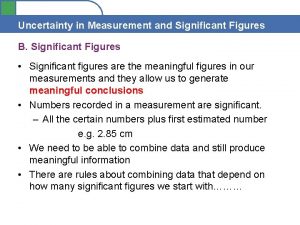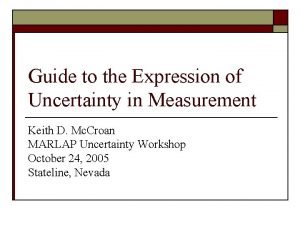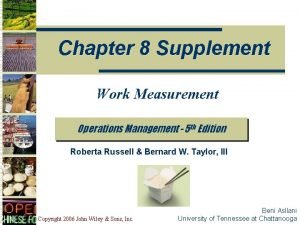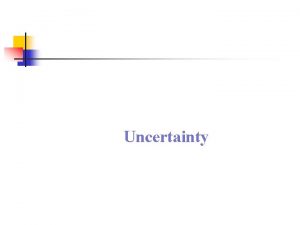Measurement uncertainty tutorial Work plan Introductory questionsthoughts from





- Slides: 5

Measurement uncertainty tutorial: Work plan • Introductory questions/thoughts from participants • Brief explanation of the Nordtest approach • Practical examples (Trace elements in Plankton) – First element will be solved by teacher – The next ones participants solve themselves, teacher will help • If needed, more theory will be explained • If general questions emerge, we will discuss Eco. Balt 2016 Tartu 09 -12. 10. 2016 1

If no stable control sample is available, how do I evaluate reproducibility? • Deep freezing • Sometimes inert environment can help • Control sample usable for a limited time and is periodically replaced – https: //sisu. ut. ee/measurement/6 -random-and-systematic-effectsrevisited • Stabilizing/Poisoning of samples Eco. Balt 2016 Tartu 09 -12. 10. 2016 2

Control sample: which matrices, how many replicates, how often, how long time period? • Matrix match: – If several CRMs, not fully matching, it is useful to use both • Time: – Long term mor important than number of replicates • 10 M, 6 R is better than 5 M 20 R Eco. Balt 2016 Tartu 09 -12. 10. 2016 3

How do I get a reference value? – From analysis of the samples with a reference procedure (same lab or different labs) • Perfect matrix match, usually no procedure available – From analysis of certified reference materials (CRMs) • Problems: matrix match can be bad, availability, price • Good: Reliable ref value, matrix match can be good – From interlaboratory comparison measurements (prof. tests) • Can be poor quality of consensus value, leads usually to overestimated bias • If many labs participate – statistical reliability, more available than CRM, often with analyte/matrix combinations for which CRMs are unavailable – From spiking experiments • Cheap, you can do in your lab, perfect matrix match • Problems with dispersing analyte in the matrix the same way as the native analyte, leads to underestimated bias Eco. Balt 2016 Tartu 09 -12. 10. 2016 4

CRM, spiking: which matrices, how many replicates, how often, how long time period? • Bias should be determined over long term, if possible Eco. Balt 2016 Tartu 09 -12. 10. 2016 5









